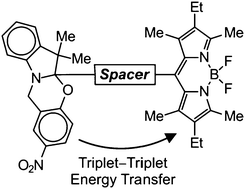We synthesized five BODIPY–oxazine dyads in one to four synthetic steps from known precursors. They differ in the nature of the unsaturated spacer linking the oxazine photochrome to either the conjugated framework or the boron center of the BODIPY fluorophore. Despite the π-character of the linkers, the two functional components are electronically isolated in the ground state and the BODIPY fluorophore maintains its absorption and, with one exception, emission properties unaltered. Instead, the photochemical response of the photochromic component is completely suppressed within all dyads. Rather than the expected opening of the oxazine ring, the laser excitation of these molecular assemblies results in the effective population of the BODIPY triplet in four of the five dyads. Control experiments with appropriate model compounds indicate that the local excitation of the oxazine component results first in intersystem crossing and then energy transfer to the BODIPY component. In fact, the transfer of energy from the triplet state of the former to the triplet state of the latter competes successfully with the opening of the oxazine ring and prevents the isomerization of the photochromic component. These observations demonstrate, for the very first time, that the photoinduced opening of these photochromic oxazines occurs along the potential energy surface of their triplet state. Such valuable mechanistic insights into their excitation dynamics can guide the design of novel members of this family of photochromic compounds with improved photochemical properties.
